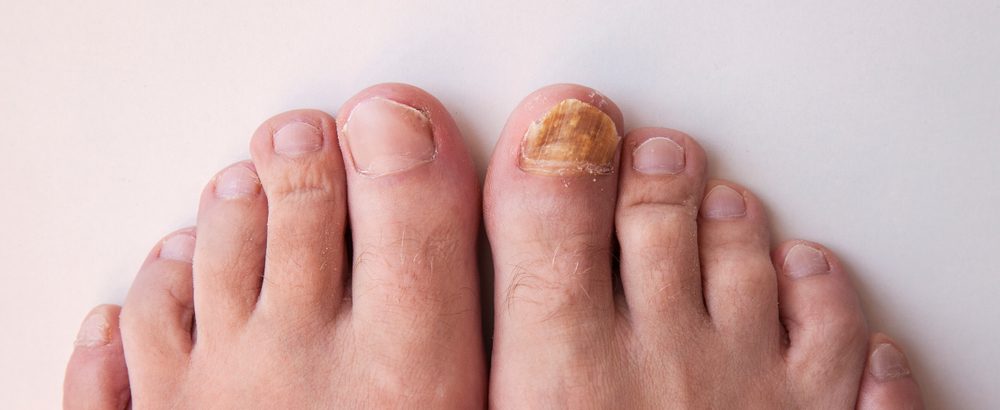Toenail Fungus: Signs, Symptoms, and Treatment

Identify Toenail Fungus Early to Get it Treated Sooner
Toenail fungus is a common ailment that many Americans experience each year. Fungal nail infections often start as white or yellow spots beneath your toenail, and if left untreated, can lead to nail discoloration, as well as thickened or crumbly nails, which can be painful. Even when treatment is successful, nail fungus often returns. Fortunately, by knowing the symptoms and being aware of prevention best practices, you can seek treatment quickly and easily and reduce the chances of reinfection.
Symptoms
According to the Mayo Clinic, many symptoms could indicate whether you have toenail fungus:
Thickened Nails
If your nails feel thicker than usual, this may be a sign of fungal infection. Compare your thicker nail to the identical nail on your other foot. If there is a notable difference, you should make an appointment with a podiatrist for an examination.
Discolored Nails
Fungal infections can also cause nail discoloration. You’ll often notice a whitish or yellowish-brown shade, which is a telltale sign that something in your toe needs treatment.
Brittle Nails
Brittle nails can crumble or have an unusual or ragged texture, which can cause uneven nail growth and pits in the nails. If you notice signs of brittle, crumbly, or ragged nails, it is essential to make an appointment to have your toes checked by a professional.
Distorted Shape
Infections may affect your nail’s ability to grow evenly and healthily. Brittle nails may also cause pieces to break off, creating an unusual shape. If your nail has an unusual shape and you do not remember chipping it, this may indicate an infection.
Foul Smell
A fungal infection can cause the toe to produce pus or create a foul odor on its own. If you notice an unusual smell, you should consider calling a podiatrist immediately.
Preventing Fungal Infections
By actively engaging in healthy foot care habits, you can prevent nail fungus, reinfections, and athlete’s foot, all of which can lead to the growth of nail fungus. Here are a few preventative habits that you can implement into your daily routine:
Wash Your Feet Regularly
Wash your feet regularly, especially if you wear open-toed footwear or have exposed your feet to untreated water. After washing your toes, you can also moisturize them to keep them soft and healthy. After touching an infected nail, you should always wash your hands.
Wear Flip Flops in Showers
Avoid taking showers in public facilities such as gyms or hotel rooms without wearing sandals or flip-flops. Otherwise, you run the risk of developing an infection. Additionally, always wear footwear while in locker rooms or pool areas.
Treat All Nail Injuries
Seek treatment for all nail injuries, even if minor. When caring for your nails, trim them straight across and smooth the edges using a file to avoid causing further damage.
Monitor Your Feet Closely
If you have diabetes, make it a habit to monitor your feet closely and notify your doctor of any sudden changes to your toenails.
Treatment
Fungal toenail infections can be challenging to treat. Your treatment will depend on the severity of your condition and the type of fungus behind the infection. There are several self-care strategies and over-the-counter products that may help, including:
Antifungal Drugs
Oral antifungal drugs are usually the first option for treating any infection because they work more quickly than topical drugs. Your podiatrist might prescribe you an oral antifungal medication to help a new, healthy, and clean nail slowly replace the infected part of your toe.
Topical Cream
Over-the-counter antifungal nail cream is another treatment option, which you rub into your infected nail(s) after soaking your foot. If a non-prescription cream doesn’t work, your doctor can prescribe you a stronger version.
Nail Removal
Some fungal toenail infections don’t respond to medicines. If other treatment options fail to heal an infected toenail, your doctor may need to perform a nail removal. By following post-removal care instructions carefully, you can ensure a healthier nail regrowth.
Get Treatment for Nail Fungus in Maryland
Getting nail fungus treated as soon as you notice symptoms is imperative for keeping your feet healthy and intact. Before arriving at your appointment, it’s a good idea to prepare by listing your symptoms, making a list of all the medications you are taking, and thinking ahead about any questions you may want to ask your podiatrist.
If you need nail fungus treatment in the Salisbury, MD area, contact us any time to make an appointment with our caring and dedicated staff.





